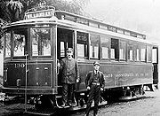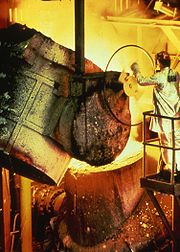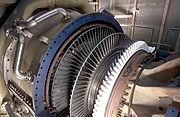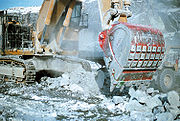
ESCO Corporation
Encyclopedia
ESCO Corporation is a manufacturer of engineered metal wearparts and components for industrial applications – including mining
, construction
, power generation and aerospace
. Since 1913, the privately held company has been headquartered in Portland, Oregon
, USA, and currently has more than 4,500 employees and 25 manufacturing sites throughout the world. The Engineered Products division designs and manufactures ground engaging tools (GET) for mining
, construction
, conveying, rigging
, dredging and other industrial applications. ESCO's Turbine Technologies division manufactures components using investment casting
or lost-wax casting techniques for aerospace
, defense
and power generation applications. The company produces such hot gas path (HGP) components as directionally solidified (DS), single crystal (SC) and equiaxed blades, nozzles, vanes and structural castings.
 ESCO was founded in 1913 by Oregon businessman Charles (C.F.) Swigert as a local source of steel castings. The Electric Steel Foundry Company was founded on property once occupied by the 1905 Lewis and Clark Centennial Exposition
ESCO was founded in 1913 by Oregon businessman Charles (C.F.) Swigert as a local source of steel castings. The Electric Steel Foundry Company was founded on property once occupied by the 1905 Lewis and Clark Centennial Exposition
. The foundry
used an unusual modern furnace that was fired by electricity rather than coke
making it the first of its kind in the western United States.
During its first 30 years, ESCO was mainly a regional supplier of cast steel alloy products for the logging, construction, and pulp and paper industry throughout the Pacific Northwest
. In the 1920s, the company expanded production to include cast steel alloy products like the Bardon choker hook, widely used in forestry. Further growth was sparked by the use of Hadfield manganese steel and the production of dragline excavator buckets. The ESCO trademark was first used in 1926 and eventually became the company’s new name.
ESCO survived the Great Depression primarily as a jobbing foundry, making castings for sawmills, pulp and paper mills. In 1932, ESCO opened its first stainless steel industrial service center. During the 1940s, ESCO added new products to meet demand for supply valves, pump bodies, anchor chains and other components for warships and tanks. In 1946, ESCO developed the two piece tooth tooth system and, in 1948, the company entered the cable excavator bucket market.
Due to the growing mining and construction markets after the war, ESCO launched new products and opened additional plants, sales offices, subsidiaries and licensees, including a midwest distribution facility in Danville, Illinois and a foundry in British Columbia. The company also adopted new manufacturing, inspection and metallurgical methods.
The 1960s and 1970s, ESCO expanded the manufacture of dragline and shovel dipper buckets and teeth. The company also launched a two-piece Conical tooth system and began using the argon oxygen decarburization
(AOD) and vacuum molding processes. During the 1970s, ESCO opened an automated foundry in Newton, Mississippi and a second Canadian foundry in Ontario.
During the early 1980s, ESCO launched its Helilok pin and lock system and also acquired Gray-Syracuse and Concorde Castings—investment casting facilities serving the aerospace and power generation industries.
During the 1990s, ESCO expanded operations in the United States, the United Kingdom and Canada and entered a joint venture to manufacture products in China. The company also acquired Heflin Steel, producing wear liners and armor plate. ESCO also introduced the Super V tooth system.
Additional acquisitions like Quality Steel are targeted to serve the oil sands market. ESCO has also added aerospace and power generation facilities in Belgium and Slovakia and built new facilities in Mexico and Xuzhou, China. In 2008, ESCO introduced the SV2 tooth system, the Whisler Plus hammerless locking system, and the Ultralok hammerless tooth system.
In 2006 and 2008, ESCO was named among Oregon's most admired manufacturing companies, according to a Portland Business Journal survey of more than 2,000 Oregon CEOs.
In May 2011, ESCO filed with the SEC to raise up to $175 million in an initial public offering.

 Hot gas path components are the expendable replacement parts (blades, nozzles, and blisks) of costly industrial gas turbines, locomotive engines and aircraft engines. These components are found deep within the engine and must withstand temperatures that often reach 1600 °C (2,912 °F) in some places. This is 400 degrees hotter than the melting point of the metal from which turbine components are generally cast. Aircraft engine blades, for example, are grown from a single crystal of alloy for strength and are then coated with tough ceramics, dotted with tiny air holes which create a thin blanket of cool air that prevents the blades from melting.
Hot gas path components are the expendable replacement parts (blades, nozzles, and blisks) of costly industrial gas turbines, locomotive engines and aircraft engines. These components are found deep within the engine and must withstand temperatures that often reach 1600 °C (2,912 °F) in some places. This is 400 degrees hotter than the melting point of the metal from which turbine components are generally cast. Aircraft engine blades, for example, are grown from a single crystal of alloy for strength and are then coated with tough ceramics, dotted with tiny air holes which create a thin blanket of cool air that prevents the blades from melting.
Ground engaging tools are the expendable replacement parts of costly mining, construction, dredging, crushing, conveying, recycling equipment such as excavators, scrapers, drag lines, shovels, dippers, graders, dozers, loaders, haulers, dredging cutter heads, backhoes and skid steers. GET protects expensive equipment from the wear and tear common in high-impact or high-abrasion environments (from hard rock mining to dredging and oil sands extraction). GET includes such wear parts as tooth systems, buckets, blades, end bits, couplers, thumbs, ripper systems, lip systems, dozer packages, liner packages, shrouds, chain, chain sprockets, traction wheels, and shredder hammer components.
ESCO is a manufacturer of products for
"Industrial air pollution in Northwest Portland is significantly worse than in other parts of the city, and ESCO Corporation is the main reason why. That conclusion can be drawn from an eight-month study by USA Today applying U.S. Environmental Protection Agency data and modeling to public and private school locations across the country. For each of the seven Northwest schools, the No. 1 source of pollution was ESCO, which has a steel foundry near Northwest Vaughn Street on 25th Avenue and another off Northwest Yeon Avenue. The primary chemicals emitted by these foundries were ..."
"... a December 2008 USA Today story, The Smokestack Effect: Toxic Air and America’s Schools, that ranked the air around Chapman and other Northwest Portland schools among the two percent most polluted in the nation. In essence, it said school children are exposed to some of America’s most unhealthy air, largely due to ESCO’s toxic fumes."
"Northwest Portland activists raised the issue of manganese pollution from ESCO foundries near Chapman Elementary after a USA Today report last December that ranked Chapman among U.S. schools most at risk from industrial pollution."
Mining
Mining is the extraction of valuable minerals or other geological materials from the earth, from an ore body, vein or seam. The term also includes the removal of soil. Materials recovered by mining include base metals, precious metals, iron, uranium, coal, diamonds, limestone, oil shale, rock...
, construction
Construction
In the fields of architecture and civil engineering, construction is a process that consists of the building or assembling of infrastructure. Far from being a single activity, large scale construction is a feat of human multitasking...
, power generation and aerospace
Aerospace
Aerospace comprises the atmosphere of Earth and surrounding space. Typically the term is used to refer to the industry that researches, designs, manufactures, operates, and maintains vehicles moving through air and space...
. Since 1913, the privately held company has been headquartered in Portland, Oregon
Portland, Oregon
Portland is a city located in the Pacific Northwest, near the confluence of the Willamette and Columbia rivers in the U.S. state of Oregon. As of the 2010 Census, it had a population of 583,776, making it the 29th most populous city in the United States...
, USA, and currently has more than 4,500 employees and 25 manufacturing sites throughout the world. The Engineered Products division designs and manufactures ground engaging tools (GET) for mining
Mining
Mining is the extraction of valuable minerals or other geological materials from the earth, from an ore body, vein or seam. The term also includes the removal of soil. Materials recovered by mining include base metals, precious metals, iron, uranium, coal, diamonds, limestone, oil shale, rock...
, construction
Construction
In the fields of architecture and civil engineering, construction is a process that consists of the building or assembling of infrastructure. Far from being a single activity, large scale construction is a feat of human multitasking...
, conveying, rigging
Rigging
Rigging is the apparatus through which the force of the wind is used to propel sailboats and sailing ships forward. This includes masts, yards, sails, and cordage.-Terms and classifications:...
, dredging and other industrial applications. ESCO's Turbine Technologies division manufactures components using investment casting
Investment casting
Investment casting is an industrial process based on and also called lost-wax casting, one of the oldest known metal-forming techniques. From 5,000 years ago, when beeswax formed the pattern, to today’s high-technology waxes, refractory materials and specialist alloys, the castings allow the...
or lost-wax casting techniques for aerospace
Aerospace
Aerospace comprises the atmosphere of Earth and surrounding space. Typically the term is used to refer to the industry that researches, designs, manufactures, operates, and maintains vehicles moving through air and space...
, defense
Defense (military)
Defense has several uses in the sphere of military application.Personal defense implies measures taken by individual soldiers in protecting themselves whether by use of protective materials such as armor, or field construction of trenches or a bunker, or by using weapons that prevent the enemy...
and power generation applications. The company produces such hot gas path (HGP) components as directionally solidified (DS), single crystal (SC) and equiaxed blades, nozzles, vanes and structural castings.
History

Lewis and Clark Centennial Exposition
The Lewis and Clark Centennial Exposition, commonly also known as the Lewis and Clark Exposition, and officially known as the Lewis and Clark Centennial American Pacific Exposition and Oriental Fair, was a worldwide exposition held in Portland, Oregon, United States in 1905 to celebrate the...
. The foundry
Foundry
A foundry is a factory that produces metal castings. Metals are cast into shapes by melting them into a liquid, pouring the metal in a mold, and removing the mold material or casting after the metal has solidified as it cools. The most common metals processed are aluminum and cast iron...
used an unusual modern furnace that was fired by electricity rather than coke
Coke (fuel)
Coke is the solid carbonaceous material derived from destructive distillation of low-ash, low-sulfur bituminous coal. Cokes from coal are grey, hard, and porous. While coke can be formed naturally, the commonly used form is man-made.- History :...
making it the first of its kind in the western United States.
During its first 30 years, ESCO was mainly a regional supplier of cast steel alloy products for the logging, construction, and pulp and paper industry throughout the Pacific Northwest
Pacific Northwest
The Pacific Northwest is a region in northwestern North America, bounded by the Pacific Ocean to the west and, loosely, by the Rocky Mountains on the east. Definitions of the region vary and there is no commonly agreed upon boundary, even among Pacific Northwesterners. A common concept of the...
. In the 1920s, the company expanded production to include cast steel alloy products like the Bardon choker hook, widely used in forestry. Further growth was sparked by the use of Hadfield manganese steel and the production of dragline excavator buckets. The ESCO trademark was first used in 1926 and eventually became the company’s new name.
ESCO survived the Great Depression primarily as a jobbing foundry, making castings for sawmills, pulp and paper mills. In 1932, ESCO opened its first stainless steel industrial service center. During the 1940s, ESCO added new products to meet demand for supply valves, pump bodies, anchor chains and other components for warships and tanks. In 1946, ESCO developed the two piece tooth tooth system and, in 1948, the company entered the cable excavator bucket market.
Due to the growing mining and construction markets after the war, ESCO launched new products and opened additional plants, sales offices, subsidiaries and licensees, including a midwest distribution facility in Danville, Illinois and a foundry in British Columbia. The company also adopted new manufacturing, inspection and metallurgical methods.
The 1960s and 1970s, ESCO expanded the manufacture of dragline and shovel dipper buckets and teeth. The company also launched a two-piece Conical tooth system and began using the argon oxygen decarburization
Argon Oxygen Decarburization
Argon oxygen decarburization is a process primarily used in stainless steel making and other high grade alloys with oxidizable elements such as chromium and aluminum. After initial melting the metal is then transferred to an AOD vessel where it will be subjected to three steps of refining;...
(AOD) and vacuum molding processes. During the 1970s, ESCO opened an automated foundry in Newton, Mississippi and a second Canadian foundry in Ontario.
During the early 1980s, ESCO launched its Helilok pin and lock system and also acquired Gray-Syracuse and Concorde Castings—investment casting facilities serving the aerospace and power generation industries.
During the 1990s, ESCO expanded operations in the United States, the United Kingdom and Canada and entered a joint venture to manufacture products in China. The company also acquired Heflin Steel, producing wear liners and armor plate. ESCO also introduced the Super V tooth system.
Additional acquisitions like Quality Steel are targeted to serve the oil sands market. ESCO has also added aerospace and power generation facilities in Belgium and Slovakia and built new facilities in Mexico and Xuzhou, China. In 2008, ESCO introduced the SV2 tooth system, the Whisler Plus hammerless locking system, and the Ultralok hammerless tooth system.
In 2006 and 2008, ESCO was named among Oregon's most admired manufacturing companies, according to a Portland Business Journal survey of more than 2,000 Oregon CEOs.
In May 2011, ESCO filed with the SEC to raise up to $175 million in an initial public offering.
Products


Ground engaging tools are the expendable replacement parts of costly mining, construction, dredging, crushing, conveying, recycling equipment such as excavators, scrapers, drag lines, shovels, dippers, graders, dozers, loaders, haulers, dredging cutter heads, backhoes and skid steers. GET protects expensive equipment from the wear and tear common in high-impact or high-abrasion environments (from hard rock mining to dredging and oil sands extraction). GET includes such wear parts as tooth systems, buckets, blades, end bits, couplers, thumbs, ripper systems, lip systems, dozer packages, liner packages, shrouds, chain, chain sprockets, traction wheels, and shredder hammer components.
ESCO is a manufacturer of products for
- Mining: surface and underground hard rock mining applications. These products include buckets, blades, end bits, couplers, wearparts, ripper systems, shanks, lip systems, dozer packages, liner packages, shrouds, and structural components. Typical equipment using wear products includes dozers, graders, excavators, draglines, shovels, dippers, loaders and haulers.
- Highway and heavy construction: highway and heavy construction products for excavators, scrapers, graders, dozers, loaders, backhoes and skid steers. These products include tooth systems, buckets, blades, end bits, couplers, thumbs, wear parts, ripper systems, lip systems, dozer packages, liner packages, shrouds, and structural components.
- Utilities and general construction: utility and general construction products for excavators, graders, dozers, loaders, backhoes and skid steers. These products include tooth systems, buckets, blades, end bits, couplers, thumbs, wearparts, ripper systems, lip systems, dozer packages, liner packages, shrouds, and structural components.
- Universal Wear Products: Kwik-Lok, Dualmet wear tiles, bimetallic wear solutions, ESCOALLOY plate, chromium carbide overlay plate, structural steel plate, custom wear liners and RemNet
- Power generation, aerospace, and defense: products such hot gas path (HGP) components as directionally solidified, single crystal and equiaxed blades, nozzles, vanes and structural castings. There are also post-cast processes such as machining, grinding, and stem drilling.
- Crushing: wear parts for various aggregate, quarry and mining applications.
- Dredging: cutter heads, wear parts and tooth systems for a variety of rock, sand and clay dredging applications.
- Forestry: grapple and bunching heads, dual function booms, single function booms, snubbers, sorting heads and swing booms for a variety of logging and wood products manufacturing applications, including advanced crawlers and skidders.
- Rigging: for a variety of construction, forestry, crane, shipping, marine and industrial wire rope applications. These products include rigging hardware, components, swagers, swage fitting, dies and spelter sockets.
- Conveying: equipment components for such applications as receiving, storage, reclaiming, recovery, pulp mills, woodyards, woodrooms and power generation. These products include long link sprockets, drums, chains, flights, attachments, drag chain sprockets and traction wheels, engineered chain, mill chain and chain attachments. The company also provides shredder hammer assemblies and spare parts.
- Recycling: various products for recycling and recovery operations. These products include hammers, grates, rotor caps, liners and other key components for various types of recycling equipment.
- Other industrial applications: various products for other industrial applications, including military and commercial armor plating, structural shredder parts for recycling, structural components for bridges and communications towers, and alloy molds and vessels for the production of nonferrous metals.
Pollution
"Crunching pollution numbers available on the Environmental Protection Agency (EPA) website, group member Bob Holmstrom found that the ESCO steel plant five blocks from Chapman Elementary had doubled its emissions of metals into the air from 2002 to 2007." "Though it strives to be the greenest city in America, an exhaustive USA Today study found that six of Portland's schools were in the worst percentile nationwide for air toxins. That puts Portland's school air quality on par with that of Cleveland, Ohio.""Industrial air pollution in Northwest Portland is significantly worse than in other parts of the city, and ESCO Corporation is the main reason why. That conclusion can be drawn from an eight-month study by USA Today applying U.S. Environmental Protection Agency data and modeling to public and private school locations across the country. For each of the seven Northwest schools, the No. 1 source of pollution was ESCO, which has a steel foundry near Northwest Vaughn Street on 25th Avenue and another off Northwest Yeon Avenue. The primary chemicals emitted by these foundries were ..."
"... a December 2008 USA Today story, The Smokestack Effect: Toxic Air and America’s Schools, that ranked the air around Chapman and other Northwest Portland schools among the two percent most polluted in the nation. In essence, it said school children are exposed to some of America’s most unhealthy air, largely due to ESCO’s toxic fumes."
"Northwest Portland activists raised the issue of manganese pollution from ESCO foundries near Chapman Elementary after a USA Today report last December that ranked Chapman among U.S. schools most at risk from industrial pollution."

